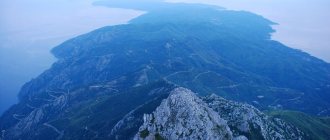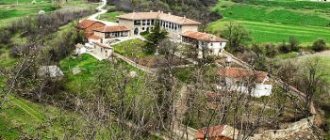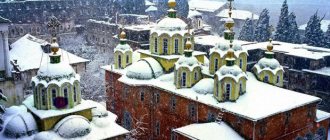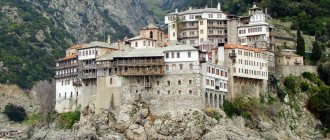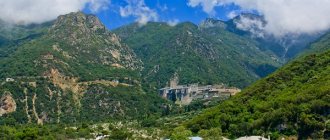Athos is a legendary peninsula on which the mountain of the same name is located (2033 meters). Athos is one of the most important revered Orthodox shrines. It was our dream to visit there. Recently it came true - we wandered around Mount Athos for more than a week - from monastery to monastery. And in this text we want to tell you in detail: how best to organize a trip to Athos and what format of pilgrimage you can choose; how to move around Mount Athos; what difficulties can you encounter on the Holy Mountain? In general: tell us how we saw it all.
Athos - the most important thing about the Holy Mountain
Athos is a monastic state located on the territory of Greece. This is a peninsula located two hours away from Thessaloniki airport.
Near Athos is the town of Uranople. It is there that pilgrims stop before Mount Athos - some overnight, some longer. Ouranopolis is a kind of spiritual “gateway” between the bustling world and the Holy Mountain. The sea, cafes - and nothing more: the soul in Ouranopol comes to a calmer and more natural rhythm.
There are dozens of monasteries and hermitages on the territory of Mount Athos. Each monastery has its own “character”, its own charter, its own national composition. There is the Russian Panteleimon Monastery, there is the Bulgarian Zograf, there is the Romanian Kutlumush, but for the most part the monasteries are Greek.
Athos is a peninsula with a distinctly mountainous landscape. You won't find even the shortest flat road - only elevation changes. Dirt roads for cars - 10–15 degrees up or down. Paths - can be 50 degrees, or even more. Climbing up is hard on the heart, going down is hard on the knees.
Athos, although it has formal civil authority over itself, is a completely monastic territory with its own laws and traditions. Women are not allowed here. Monasteries accept tourists for a maximum of one day each (if you want longer, work on obediences). In the evening they all close the gates - those who didn’t make it in time are late. And the only place where you can find grocery and hardware stores, cafes and a tiny hotel is the “capital” of Athos, the town of Kareya, with its own small hospital and tiny police station.
In general, the Holy Mountain is one of the places where you cannot, in the usual sense, control anything and claim your rights. The maximum is to plan movement from one point to another. And the external form of all trips to Athos is essentially the same - a night in one monastery, during the day - moving to another.
However, even this can be approached in different ways. There are essentially three formats for pilgrimage to Athos.
Historical background and overview of local fauna
Holy Mount Athos is geographically a peninsula and a place of pilgrimage. The mountain has a height of 2200 m above sea level and is under the control of 20 Orthodox monasteries. Almost the entire territory, with the exception of the southern peak, is covered with rich subtropical vegetation. Tourists can find luxurious fruit trees, oranges, lemons, and fields planted with grapes. The fauna of Mount Athos is diverse. It is usually represented by roe deer, lynxes, and wild boars.
Fans of outdoor activities are advised not to set off on their own: there is a high probability of encountering a poisonous snake or scorpion.
The history of Athos goes back to the distant past; the names of great monks and healers remained forever in the annals of this amazing place. The Holy Mountain is a real paradise for prayer and worship.
View of the monastery. located on the Holy Mountain
On almost every sacred altar you can see icons and touch the relics of Athonite seers who dedicated their entire lives to God. There have been sad times in history. In 1205, Saint Athos was captured and ravaged by the knights of the Crusade, and in 1453 the city came into the possession of the Turks, who mocked and tortured the local population. More than once blood was shed on the holy land, Athos suffered from raids by pirates and robbers who sought to take possession of miraculous relics and relics.
In 1913, Athos officially became part of Greece and retained its sovereignty, culture and customs. Now this small and hospitable peninsula happily welcomes travelers and pilgrims from all over the world and allows you to take a tour of mysterious caves and abandoned altars.
We recommend watching a documentary about the island of Athos.
Athos: which trip format to choose?
- A group pilgrimage organized by a pilgrimage center or a local guide . Most often, group. You just pay money, and everything else - routes, transfers, tickets - is organized by the intermediary. On the one hand, it’s convenient and you don’t have to think about anything. On the other hand, this format is gradually becoming a thing of the past. Pilgrimage requires concentration, but in a group - even if like-minded people have gathered - it is almost impossible.
- A pilgrimage, when you organize everything yourself , book places in the monasteries yourself, and travel between them by transport yourself - by buses, ferries or hired cars. We call this format “comfortable immersion.” You will see Athos and its monasteries, you will feel comfortable and good - you will not have to make exhausting treks. Generally speaking, if you are a pensioner or have health problems, this is essentially the best option.
- "Full immersion". Moving between monasteries on foot. This is a huge amount of work (more on that below), sometimes exhausting. Plus worship services! However, they say: it is in this rhythm that real and unconditional contact with Athos occurs. You don’t just look at the beauty of the Holy Mountain and its monasteries, but you become part of them. Athos seems to be not only around or at the emotional level, but also literally inside you.
Athos. Iveron Monastery.
Mount Athos, cost of travel
This is our experience. The trip lasted 13 days and 12 nights. We spent three of them in Uranople. Everything cost about 1200 euros.
The budget for the Athos trip consists of four parts:
- Visas (Greek and Athos), flights and insurance;
- Stay in Ouranopolis near Mount Athos (hotel, lunch-dinner);
- Traveling to and around Mount Athos;
- Souvenirs
A visa to Greece costs from 35 Euro. Tickets start from 300 euros, depending on the dates and how far in advance you buy them. Non-refundable tickets, as usual, are cheaper, but they are non-refundable
